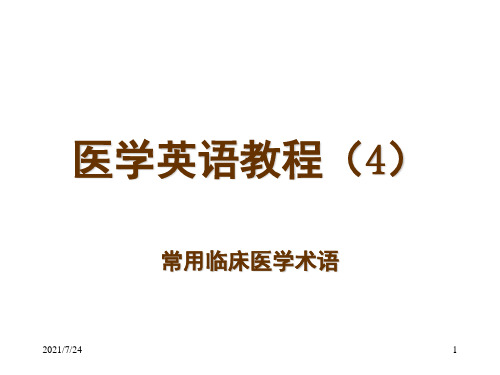医学英语术语英文课件
合集下载
医学英语术语精品课件

医学英语术语精品课件
xx年xx月xx日
目 录
• 医学英语术语概述 • 医学英语术语的发音和拼写 • 医学英语术语的学习和应用 • 医学英语术语的翻译和解释 • 医学英语术语的词汇和表达 • 医学英语术语精品课件总结与展望
01
医学英语术语概述
医学英语术语的特点
科学性和严谨性
医学英语术语表达准确、严谨,遵循科学原则。
02
学习医学英语术语的 语境含义
医学英语术语在不同的语境下可能有 不同的含义,学习这些不同含义及其 用法可以帮助学生更好地应用术语。
03
积累医学英语术语的 用法
医学英语术语的用法多且复杂,学生 需要不断地积累学习,建立自己的词 汇库,以便在需要时可以迅速查找和 使用。
医学英语术语在医学文献中的应用
注意字母组合
医学英语术语中的字母组合往往有一定的规律可循,如“-itis”、“-ectomy”等,掌握 这些组合可以帮助您更好地拼写医学英语术语。
习惯使用缩写
医学英语术语中有很多常用的缩写,如“CBC”、“AST”等,使用这些缩写可以提高书 写效率。
医学英语术语的常用缩写和符号
常用缩写
如AST(Aspartate Aminotransferase)、 ALT(Alanine Aminotransferase)、 CBC(Complete Blood Count)等。
词根和前缀
医学英语术语多基于拉丁语和希腊语词根、前缀,如 “cardio-”表示“心脏”,“-ectomy”表示“切除术 ”。
专业性强
医学英语术语通常只在医学领域使用,表达精确、专业 。
医学英语术语的表达方式和特点
缩写和简写
同义词和近义词
医学英语术语常采用缩写和简写形式 ,如“CAD”代表“冠状动脉硬化性 心脏病”。
xx年xx月xx日
目 录
• 医学英语术语概述 • 医学英语术语的发音和拼写 • 医学英语术语的学习和应用 • 医学英语术语的翻译和解释 • 医学英语术语的词汇和表达 • 医学英语术语精品课件总结与展望
01
医学英语术语概述
医学英语术语的特点
科学性和严谨性
医学英语术语表达准确、严谨,遵循科学原则。
02
学习医学英语术语的 语境含义
医学英语术语在不同的语境下可能有 不同的含义,学习这些不同含义及其 用法可以帮助学生更好地应用术语。
03
积累医学英语术语的 用法
医学英语术语的用法多且复杂,学生 需要不断地积累学习,建立自己的词 汇库,以便在需要时可以迅速查找和 使用。
医学英语术语在医学文献中的应用
注意字母组合
医学英语术语中的字母组合往往有一定的规律可循,如“-itis”、“-ectomy”等,掌握 这些组合可以帮助您更好地拼写医学英语术语。
习惯使用缩写
医学英语术语中有很多常用的缩写,如“CBC”、“AST”等,使用这些缩写可以提高书 写效率。
医学英语术语的常用缩写和符号
常用缩写
如AST(Aspartate Aminotransferase)、 ALT(Alanine Aminotransferase)、 CBC(Complete Blood Count)等。
词根和前缀
医学英语术语多基于拉丁语和希腊语词根、前缀,如 “cardio-”表示“心脏”,“-ectomy”表示“切除术 ”。
专业性强
医学英语术语通常只在医学领域使用,表达精确、专业 。
医学英语术语的表达方式和特点
缩写和简写
同义词和近义词
医学英语术语常采用缩写和简写形式 ,如“CAD”代表“冠状动脉硬化性 心脏病”。
医学专业英语术语课件

医学专业英语术语的未来发展趋势
05
医学专业英语术语的发展趋势
专业化趋势
医学专业英语术语不断细化,针对不同医学领域的术语不断涌现,如神经医学、肿瘤学、免疫学等。
随着医学科学的不断发展,新的医学概念和治疗方法不断出现,相应的医学英语术语也在不断更新换代。
医学专业英语术语的国际标准化趋势日益明显,如采用国际疾病分类标准(ICD)等。
冗长和复杂
医学术语往往较长且复杂,有时可能难以理解和记忆。
专业和领域特定
医学术语仅在医学领域使用,不与其他类型的英语混用。
01
02
03
用词差异
医学英语使用大量专业术语,而其他类型的英语可能不使用这些术语。
语法差异
医学英语经常使用复杂的句子结构和特定的语法,这可能与其他类型的英语不同。
语境差异
医学英语中的单词和短语通常只能在医学语境中使用,而其他类型的英语则不一定。
查阅词典
遇到不确定的医学英语术语时,应及时查阅权学专业英语术语的注意事项
注意文化差异
医学英语术语在不同文化背景下的表达可能存在差异,应注意跨文化交流中的术语使用。
关注更新和发展
医学专业英语术语会随着医学科学的发展而不断更新和变化,应注意关注最新动态和变化趋势。
重视术语的规范使用
医学专业英语术语有严格的规范和标准,应遵循规范使用原则,避免随意杜撰或篡改。
医学专业英语术语的应用场景及实例
04
医学专业英语术语在医学文献中广泛应用于描述疾病症状、病理生理过程、诊疗手段等。
例如,描述糖尿病的病理生理过程,会用到术语“insulin resistance”(胰岛素抵抗)。
医学文献交流
THANK YOU.
医学英语词汇ppt课件

Classification of Medical English Vocabulary
Anatomy
Terms related to the study of the structure and function of the human body, such as "cardiovascular system" and "digestive tract".
04
Medical imaging English
vocabulary
X-ray imaging vocabulary
X-ray machine: 用 于产生X射线的设备。
X-ray image: 通过X 射线产生的影像。
X-ray film: 用于捕捉 X射线的胶片。
CT imaging vocabulary
Efficient Patient Care: Providers who have a robust medical vocabulary are better equipped to gather patient history, perform physical examinations, and diagnose conditions quickly and accurately.
Procedures and Tests
Language associated with medical procedures, such as "MRI" and "CBC," as well as tests like "ECG" and "ultrasound."
Pharmacology
医学专业英语课件14

to time. – Her illness hangs in the balance
Present History
– Persistent fever – Intermittent fever – Patient had frequent episodes of vomiting – An attack lasted on the average 4 to 5 hours – The entire attack lasted for less than a minute – The attack lasted a variable time from a few
age
Past Medical History
– To have no…except ( or apart from )…
He has had no other disease except bronchitis
– To be liable to…,to be subject to …, to be apt to…
coughing before (There was ) no history of arthralgia in the past He has never been short of breath no exertion
Past Medical History
Past history was free from any suggestion of cerebritis Not pertinent Noncontribututory
he stopped smoking two months ago
Drink
He denies the use of alcoholic beverages He drinks only occasionally and in moderation
Present History
– Persistent fever – Intermittent fever – Patient had frequent episodes of vomiting – An attack lasted on the average 4 to 5 hours – The entire attack lasted for less than a minute – The attack lasted a variable time from a few
age
Past Medical History
– To have no…except ( or apart from )…
He has had no other disease except bronchitis
– To be liable to…,to be subject to …, to be apt to…
coughing before (There was ) no history of arthralgia in the past He has never been short of breath no exertion
Past Medical History
Past history was free from any suggestion of cerebritis Not pertinent Noncontribututory
he stopped smoking two months ago
Drink
He denies the use of alcoholic beverages He drinks only occasionally and in moderation
医学英语词汇课件(简版)

7、肺lung: 词根: pneumon(o)-,pulmo(n)(o)例词: pneumonia肺炎;pulmonary肺的
8、胸chest: 词根: thorac(o)例词: thoracentesis胸腔穿刺术;
❖Respiratory distress syndrome
❖ Pneumonia ❖Lung ventilation ❖ Metabolic
词源
❖ 拉丁语: ❖ ❖ 借自拉丁语的前缀: ❖ re-(再,又,重新);centi-(百)
❖ 借自拉丁语的词根: ❖ audi(o)-(听觉,听力); urin(o)-(尿)
❖ 借自拉丁语的单词: ❖ medicine-(医学);tumor-(肿瘤)
❖阿拉伯语: syrup… ❖ ❖法语: hospital; benigh…
myopia; near-sighted; near/short-sightedness
小便: urinate(V.); urine(n.) pass water; pee
医学英语词汇结构
❖ 医学词素(morpheme): ❖ 医学词根(root) ❖ 医学词缀(affix:prefix,suffix)
口流畅。
连接元音字母大多出现在两个词素相连而后一个词 素的起始字母发辅音的情况下,尤其是在前一 个词素的末尾字母发辅音而后一个词素的起始 字母也发辅音的情况下。
6个连接元音字母: o:为最常见的连接元音字母 i:为较常见的连接元音字母 a,e,u:较少见的连接元音字母 y:为最少见连接元音字母
❖-o-: therm(温)+meter(测量器): thermometer ❖-i-: insect(虫)+cide(杀): insecticide ❖-a-: pent(五)+gon(角): pentagon ❖-e-: liqu(液)+fy(…化): liquefy ❖-u-: cent(百)+ple(倍): centuple
8、胸chest: 词根: thorac(o)例词: thoracentesis胸腔穿刺术;
❖Respiratory distress syndrome
❖ Pneumonia ❖Lung ventilation ❖ Metabolic
词源
❖ 拉丁语: ❖ ❖ 借自拉丁语的前缀: ❖ re-(再,又,重新);centi-(百)
❖ 借自拉丁语的词根: ❖ audi(o)-(听觉,听力); urin(o)-(尿)
❖ 借自拉丁语的单词: ❖ medicine-(医学);tumor-(肿瘤)
❖阿拉伯语: syrup… ❖ ❖法语: hospital; benigh…
myopia; near-sighted; near/short-sightedness
小便: urinate(V.); urine(n.) pass water; pee
医学英语词汇结构
❖ 医学词素(morpheme): ❖ 医学词根(root) ❖ 医学词缀(affix:prefix,suffix)
口流畅。
连接元音字母大多出现在两个词素相连而后一个词 素的起始字母发辅音的情况下,尤其是在前一 个词素的末尾字母发辅音而后一个词素的起始 字母也发辅音的情况下。
6个连接元音字母: o:为最常见的连接元音字母 i:为较常见的连接元音字母 a,e,u:较少见的连接元音字母 y:为最少见连接元音字母
❖-o-: therm(温)+meter(测量器): thermometer ❖-i-: insect(虫)+cide(杀): insecticide ❖-a-: pent(五)+gon(角): pentagon ❖-e-: liqu(液)+fy(…化): liquefy ❖-u-: cent(百)+ple(倍): centuple
医学英语词汇 PPT课件

2018/12/3
5
Exercises—give definition
of the following words
• • • • • • cardiocentesis cardiorrhaphy glossorrhaphy proctopexy Scapulectomy lithotripsy • • • 心脏穿刺术 心脏缝合术 舌缝合术
creation of a permanent opening
cutting into, incision
7
Diagnostic and Symtomatic Suffixes
Suffix Meaning Word Meaning
-oma tumor -emia blood condition -malacia soft, softening -megaly large, enlargement -philia love -phobia fear
2018/12/3
MEANING hernia inflammation softening science and study enlargement repair love fear examination cutting, incision one who specializes in
9
Suffixes Review
SUFFIXES
Root dent (tooth) gastr (stomach) pharmac (drug) in) cardi (heart) Suffix New Word al (pertaining to) dental ic (pertianing to) gastric ist pharmacist (one who specializes
医学英语教程PPT课件

2021/7/24
9
• abscess 脓肿 • acidosis 酸中毒 • adhesion 粘连
• alkalosis 碱中毒
• allergy 过敏
• coagulation defect 凝血不良
• congestion 充血
• dehydration 脱水 • distention 膨胀 • edema 水肿
医学英语教程(4)
常用临床医学术语
2021/7/24
1
diseases 疾病
• acute diseases 急性病 • advanced diseases 病沉重期,晚期疾病 • chronic diseases慢性病 • communicable diseases 传染病 • complicating diseases 并发病 • congenital diseases 先天性疾病 • acquired diseases 后天性疾病 • contagious diseases接触性传染病 • endemic diseases 地方病 • epidemic diseases 流行病
发病机制
• personal history
个人史
2021/7/24
4
symptoms 症状
• cardinal symptom 主要症状 • classical symptom 典型症状 • concomitaitutional(systemic) symptom 全身症状 • indirect symptom 间接症状 • induced symptom 诱发症状 • local symptom 局部症状 • mental symptom精神症状
• terminal diseases 绝症
最新医学英语词汇讲解精品课件

• in consultation with 经与…磋商
• technical consultation 技术咨询 psychological consultation 心理咨询
consultation company 咨询公司
第七页,编辑于星期六:十二点 五十七分。
unit 24 depression
• alcohol 酒精 • holic 中毒,沉迷于某事
ห้องสมุดไป่ตู้
• alcoholic beverage 酒精饮料
• alcoholic fermentation [化]酒精发酵 alcoholic liquor [医]醇制溶液;含醇液 alcoholic extract 酒精提出物,酒精萃取物 alcoholic hepatitis 酒精性肝炎
第十一页,编辑于星期六:十二点 五十七分。
shaggy
• Shaggy hair or fur is long and messy. (毛发 等) 又长又乱的
第十二页,编辑于星期六:十二点 五十七分。
tend伸出头探望ian表示人称名词physicianintern实习医生doctorcharge主治医生risidentphysician住院医生chiefresident主任医生alcoholalcohol酒精holic中毒沉迷于某事alcoholicbeverage酒精饮料alcoholicfermentation化酒精发酵alcoholicliquoralcoholicextract酒精提出物酒精萃取物alcoholichepatitis酒精性肝炎alcoholismpeoplewhosufferfromalcoholismcannotstopdrinkinglargequantitiesism行为状态chronicalcoholism慢性酒中毒
- 1、下载文档前请自行甄别文档内容的完整性,平台不提供额外的编辑、内容补充、找答案等附加服务。
- 2、"仅部分预览"的文档,不可在线预览部分如存在完整性等问题,可反馈申请退款(可完整预览的文档不适用该条件!)。
- 3、如文档侵犯您的权益,请联系客服反馈,我们会尽快为您处理(人工客服工作时间:9:00-18:30)。
Measuring the pulse rate
Measuring blood pressure with a sphygmomanometer
Additional tools used in physical examinations include the ophthalmoscope (, for examination of the eyes; the otoscope , for examination of the ears; hammers, for testing reflexes, and the blood pressure cuff or sphygmo manometer
examine (sth) by feeling with the hands, esp as part of a medical examination
• Percussion(precussion sound): tapping the body and listening to the sounds produced . • Auscultation: listening to body sounds with a stethoscope
A physical examination, which includes a review of all systems and observation of any signs of illness, follows the history taking. Practitioners use the following techniques in performing physicals:
magnetic磁性的
Treatment
If diagnosis so indicates, treatment, also termed therapy, is begun. This may consist of counseling, drugs,surgery, radiation, physical therapy, occupational therapy, psychiatric treatment, or a combination of these. During diagnosis and throughout the course of treatment, a patient is evaluated to establish a prognosis, that is, a prediction of the outcome of the disease.
• Blood pressure (BP), measured in millimeters mercury (mm Hg) and recorded when the heart is contracting (systolic pressure) and relaxing (diastolic pressure)
prefix meaning "the chest
检查镜 ultrasonic scope ultrasonic stethoscoe
Percussion
Auscultation using a stethoscope scop- = look at, inspect
(from the Greek root steth/o, meaning “chest”)
DISEASE AND TREATMENT
Diagnosis
Medical diagnosis, the determination of the nature and cause of an illness, begins with a patient history. This includes a history of the present illness with a description of symptoms, a past medical history, and a family and a social history.
Practitioner:person who practises as a profession General ection: visual examination. • Palpation: touching the surface of the body with the hands or fingers.
Vital signs (VS) are also recorded for comparison with normal ranges. Vital signs are measurements that reflect basic functions necessary to maintain life and include: • Temperature (T). • Pulse rate, measured in beats per minute (bpm) • Respiration rate (R), measured in breaths per minute.
(A) Ophthalmoscope. (B) Otoscope
Ophthalm o scope ophthalmic lens ophthalmology
Oto scope
Imaging Techniques Imaging techniques are the use of various physical forces to produce visual images of the body. The most fundamental imaging method is radiography, which uses x-rays to produce a picture (radiograph) on sensitized film. Radiography is best at showing dense tissues, such as bone, but views of soft tissue can be enhanced by using a contrast medium, such as a barium mixture, to outline the tissue. Other forms of energy used to produce diagnostic images include sound waves, radioactive isotopes, radio waves, and magnetic fields.
